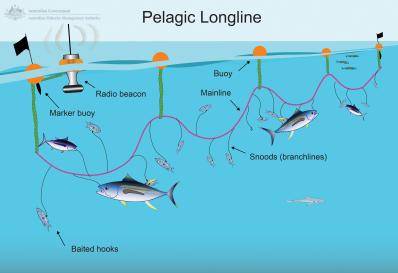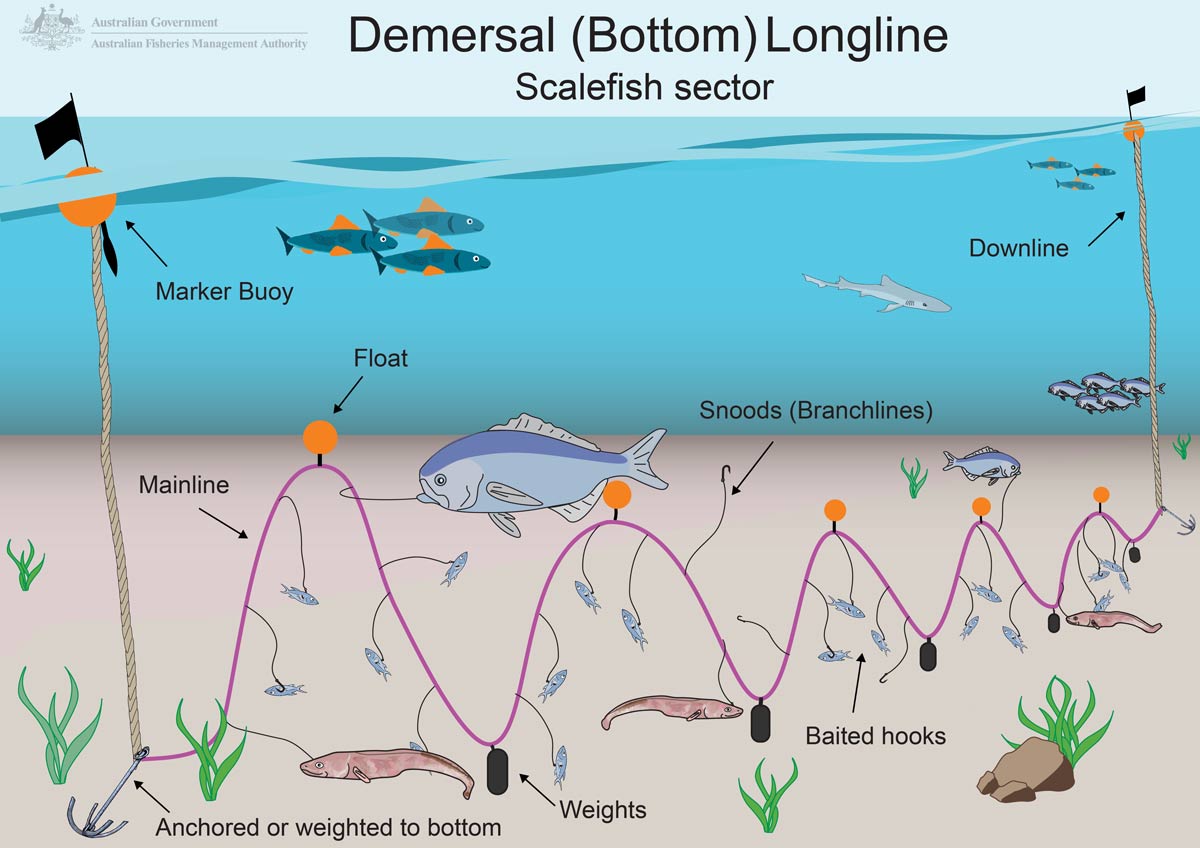
Pelagic (mid-water) longline
Species targeted
Pelagic longlines are usually used to catch large tuna and billfish species.
How they work
Baited hooks are attached to the longline by short lines called snoods that hang off the mainline. The longline can be many kilometres long and can carry thousands of hooks.
Pelagic longlines are not anchored and are set to drift near the surface of the ocean with a radio beacon attached so that the vessel can track them to haul in the catch.
Environmental impacts and management
Sometimes longlines can catch bycatch species like sharks, turtles, marine mammals and seabirds.
Bycatch can be reduced in a variety of ways including circle hooks to prevent catching turtles, and setting deeper lines to reduce catches of turtles, sharks and marine mammals. Techniques such as setting lines quickly and at a greater depth, using bird scarers, and setting at night can reduce the number of seabirds that get caught on hooks and drown when diving for bait.

Bottom (demersal) longlines are set horizontally along the ocean floor, and are held in place using anchors. The primary difference between bottom longline fishing and auto longline fishing is that hooks are baited by hand rather than a machine.
When set, the longline can be many kilometres in length and have several thousand hooks.
Bottom longlines are used to catch shark species that live on or near the sea floor in shelf waters generally less than 100m deep.
Species targeted
Bottom longlines target species including:
How bottom longlines work
Bottom longline gear consists of a rope mainline with baited hooks spaced every 2 to 5m on monofilament or braided cord snoods. The mainline is attached at both ends to downlines which have a large buoy on the surface for locating gear, and anchors at the bottom to hold the gear in place. Hauling is done using hydraulic winches which are fixed to the deck of the boat. The gear can be hauled from either end by retrieving the downline.
Environmental impacts and management
Bottom longline fishing causes very little damage to the sea floor and has only a very limited level of bycatch. Gear can become snagged on the bottom and get broken off, although this is not a common occurrence.
Fish which have been hooked are brought to the surface slowly, and are often alive when they reach the boat, which greatly increases the likelihood of survivability for non-target species returned to the water.
Auto longline fishing is a type of bottom longlining, where gear is set horizontally along the ocean floor and held in place using anchors. The primary difference between auto longline and demersal longline fishing is that hooks are baited by a machine rather than by hand. When set, the longline can be many kilometres in length, incorporating up to 15,000 hooks.
Automatic longlines are used to catch finfish that live on or near the sea floor primarily along Australia’s Continental shelf break in 200 to 800m of water.
Target species
Automatic longline fishers target:
How auto longline gear works
Auto longline gear typically consists of a rope mainline with hooks spaced every 1.3m on 40cm monofilament or braided cord lines (‘snoods’). The mainline is attached at both ends to downlines which have a large buoy on the surface for locating gear, and anchors at the bottom to hold the gear in place. Each line is normally left to ‘soak’ for around 6 to 8 hours before being hauled. Hauling is done using hydraulic winches which are fixed to the deck of the boat. The gear can be hauled from either end by retrieving the downline.
Environmental impacts and management
Auto longline fishing causes very little damage to the sea floor. Gear can become snagged on the bottom and get broken off, although as gear loss is costly to fishing operations, all attempts are made to avoid losing gear. Auto longline fishers can catch deepwater shark species such as Harrison’s and southern dogfish, although AFMA manage the impacts of fishing on deepwater shark species under the Upper Slope Dogfish Management Strategy through a network of area closures.
In recent years, AFMA in conjunction with the Department of Environment and the fishing industry have worked hard to reduce seabird interactions with auto longline gear. Seabird bycatch is managed through strict conditions on fishing permits which are supported by the Threat Abatement Plan for the incidental catch (or bycatch) of seabirds during oceanic longline fishing operations.